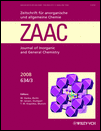Synthese und Kristallstrukturen der Bismutchalkogenolate Bi(SC6H5)3, Bi(SeC6H5)3 und Bi(S-4-CH3C6H4)3
Abstract
Synthesis and Crystal Structures of Bismuth Chalcogenolato Compounds Bi(SC6H5)3, Bi(SeC6H5)3, and Bi(S-4-CH3C6H4)3
Bismuth(III) acetate reacts with thiophenol in ethyl alcohol at 80 °C to yield Bi(SC6H5)3 (1). Slow cool down of the deep yellow mixture lead to the formation of orange crystals of 1. The homotype phenylselenolato compound of bismuth Bi(SeC6H5)3 (2) has been prepared by the reaction of BiX3 (X = Cl, Br) with Se(C6H5)SiMe3 in diethyl ether. In the same way as Bi(SC6H5)3 (1) the reaction between bismuth(III) acetate and 4-tolulenethiole results in red crystals of Bi(S-4-CH3C6H4)3 (3). In consideration of three longer Bi–E distances (intermolecular interactions, E = S; Se) the Bi(EPh)3 molecules form via face-linked octahedra 1-dimensional chains in the crystal lattice, while for 3 the 1-dimensional chain is formed by face-linked trigonal prisma. We reported herein the synthesis and structures of Bi(SC6H5)3 (1), Bi(SeC6H5)3 (2), and Bi(S-4-CH3C6H4)3 (3).




